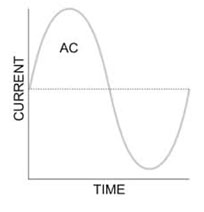| Alternating current |
Direct current |
| 1.Alternating current is the flow of electric charge that changes direction periodically. |
1.Direct current is the flow of electric charge that only flow in one direction i.e unidirectional |
| 2. In Alternating current, Rotating magnet along with the wire cause the direction of flow of electron. |
2. In Direct current, Steady magnetism along the wire causes the direction of flow of electron. |
| 3. The Alternating current changes its polarity and magnitude periodically w.r.t. time |
3. Unlike Alternating current, direct current does not change the polarity and magnitude with time.
|
| 4. The current time graph for an Alternating current is a sine curve graph .
 
|
4.The current time graph for a Direct current as shown below.

|
| 5. Alternating current is produced in power systems. |
5. Direct current is produced by cells and batteries. |
| 6. Alternating current can be transmitted to long distance. |
6.Direct current cannot be easily transmitted to long distance because of very large energy loss. |
| 7. Depending upon country, Frequency of Alternating current is 50 Hz to 60Hz. |
7.Frequency of Direct current is zero. |
| 8. Source of availability in ac is generator or mains. |
8. Source of availability in dc is battery or cell. |
| 9. In ac, Power factor lies between 0 & 1. |
9. In dc, Power factor is always 1. |
| 10. It has more efficiency as compared to dc. |
10. It has less efficiency as compared to ac. |
| 11. Power consumption is less. |
11. Power consumption is more as compared to ac. |
| 12. Alternating current has higher voltage hence, it is not safe |
12.Direct current has low voltage hence, it has safe operation. |
| 13. In Alternating current, any terminal can be connected to the work or electrode. |
13. In Direct current, positive terminal connected to the work and negative terminal connected to the electrode. |
| 14. Impedance is passive parameter of alternating current. |
14. Resistance is passive parameter of direct current. |